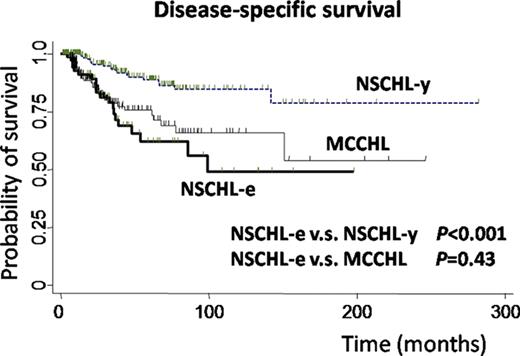Abstract
Abstract 2677
Classical Hodgkin lymphoma (CHL), which is characterized by the presence of Hodgkin and Reed Sternberg (H-RS) cells in a background of non-neoplastic inflammatory cells, is divided into four histological subgroups, nodular sclerosis (NSCHL), mixed cellularity (MCCHL), lymphocyte-rich, and lymphocyte depletion. While NSCHL in young adults is characterized by a mediastinal mass and good prognosis, the clinicopathological characteristics of NSCHL in the elderly (NSCHL-e) remain uncertain.
Enrolled patients were diagnosed with CHL between 1986 and 2006 as part of the Hodgkin Lymphoma's Multicenter Study Group. To better characterize NSCHL-e, we compared the clinicopathological profiles of 84 NSCHL-e patients aged 50 or over with 237 NSCHL-y patients aged 49 or younger and 302 with MCCHL.
The total of 743 CHL patients consisted of 496 men and 247 women with a median age of 48 years (range, 15– 89 years). The pathological diagnoses were NSCHL in 324 patients (43%) and MCCHL in 303 (41%). NSCHL patients showed a bimodal age distribution, with an initial peak in their 20s and a second small peak in their 60s. We categorized the former as NSCHL-y (49 or younger) and the latter as NSCHL-e (50 and over). NSCHL-e patients were characterized by male predominance and a more advanced clinical stage (53%) than NSCHL-y. Immunophenotypically, H-RS cells had the prototypic immunophenotype of CD15+ CD30+ and Pax5+. NSCHL-e cases showed a significantly higher rate of CD20 (24%) than NSCHL-y (8%, P = 0.001). Furthermore, H-RS cells in 29 of 75 (39%) patients with NSCHL-e were positive for EBV RNA transcripts by in situ hybridization, whereas only 7% of NSCHL-y cases were EBER-positive (P < 0.0001) (Table). Regarding NSCHL-e and MCCHL, no significant difference between these patients was seen in clinical characteristics. Immunophenotypically, NSCHL-e patients showed significantly higher rates for CD3 and TIA-1, while MCCHL patients showed higher EBV positivity (75%). Fifty-five of 63 patients received systemic multi-agent chemotherapy as first-line treatment, consisting of doxorubicin, bleomycin, vinblastine, and dacarbacin (ABVD) in 38 patients; CHOP in 8; C-MOPP in 8; and BEACOPP in 1. Overall, 51 patients responded to first-line treatment, 39 with complete response and 12 with partial response. Disease-specific survival of NSCHL-e was poorer than that of NSCHL-y (P < 0.001) but similar to that of MCCHL (P = 0.43) (Figure).
NSCHL-e is characterized by an unfavorable prognosis and different clinicopathological features to NSCHL-y, which is considered as typical NSCHL. A number of cases of NSCHL-e might have been associated with MCCHL, with most being EBV-positive. These results suggest the limitations of current histological subgroupings for CHL.
Clinical and phenotypic characteristics between NSCHL in the elderly (NSCHL-e) and NSCHL in the young adults (NSCHL-y)
| . | NSCHL-e (n=84) . | NSCHL-y (n=237) . | P* . | ||
|---|---|---|---|---|---|
| Sex (male/female) . | 63/21 . | 116/121 . | <0.0001 . | ||
| Age(y), median(range) | 65 (50–86) | 27 (9–49) | − | ||
| PS >1 | 10 | (18%) | 19 | (12%) | 0.32 |
| Stage III/IV | 41 | (53%) | 70 | (32%) | 0.001 |
| B symptoms | 32 | (41%) | 74 | (34%) | 0.29 |
| Extranodal >1site | 6 | (8%) | 19 | (9%) | 0.74 |
| BM involvement | 4 | (5%) | 10 | (5%) | 0.85 |
| LDH >normal | 40 | (63%) | 94 | (53%) | 0.14 |
| Immunophenotype | |||||
| cyCD3 | 3/36 | (8%) | 4/79 | (5%) | 0.50 |
| CD15 | 50/78 | (64%) | 145/219 | (66%) | 0.74 |
| CD30 | 73/79 | (92%) | 208/219 | (95%) | 0.40 |
| CD20 | 13/54 | (24%) | 12/155 | (8%) | 0.001 |
| EBV | 29/75 | (39%) | 14/207 | (7%) | <0.0001 |
| TIA-1 | 6/59 | (10%) | 8/161 | (5%) | 0.16 |
| . | NSCHL-e (n=84) . | NSCHL-y (n=237) . | P* . | ||
|---|---|---|---|---|---|
| Sex (male/female) . | 63/21 . | 116/121 . | <0.0001 . | ||
| Age(y), median(range) | 65 (50–86) | 27 (9–49) | − | ||
| PS >1 | 10 | (18%) | 19 | (12%) | 0.32 |
| Stage III/IV | 41 | (53%) | 70 | (32%) | 0.001 |
| B symptoms | 32 | (41%) | 74 | (34%) | 0.29 |
| Extranodal >1site | 6 | (8%) | 19 | (9%) | 0.74 |
| BM involvement | 4 | (5%) | 10 | (5%) | 0.85 |
| LDH >normal | 40 | (63%) | 94 | (53%) | 0.14 |
| Immunophenotype | |||||
| cyCD3 | 3/36 | (8%) | 4/79 | (5%) | 0.50 |
| CD15 | 50/78 | (64%) | 145/219 | (66%) | 0.74 |
| CD30 | 73/79 | (92%) | 208/219 | (95%) | 0.40 |
| CD20 | 13/54 | (24%) | 12/155 | (8%) | 0.001 |
| EBV | 29/75 | (39%) | 14/207 | (7%) | <0.0001 |
| TIA-1 | 6/59 | (10%) | 8/161 | (5%) | 0.16 |
Abbreviations: NSCHL-e: nodular sclerosis type classical Hodgkin lymphoma in the elderly; NSCHL-y: nodular sclerosis type classical Hodgkin lymphoma in the young adults; PS: performance status; BM; bone marrow.
NSCHL-e versus NSCHL-y
Matsushita:Pfizer CO.: Membership on an entity's Board of Directors or advisory committees, Research Funding; Baxter Co.: Membership on an entity's Board of Directors or advisory committees, Research Funding.
Author notes
Asterisk with author names denotes non-ASH members.


This feature is available to Subscribers Only
Sign In or Create an Account Close Modal